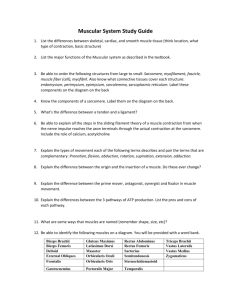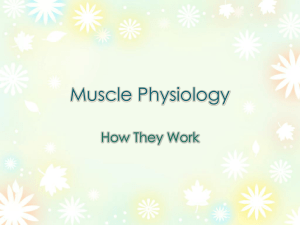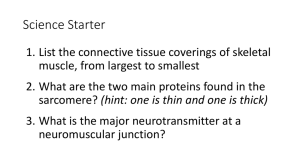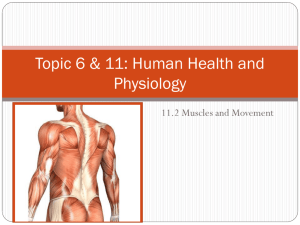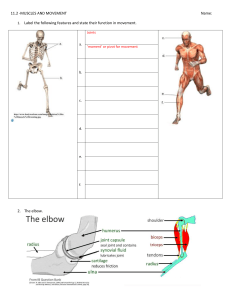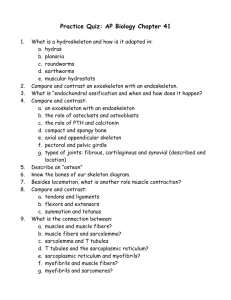Skeletal muscle cell (fiber)
advertisement
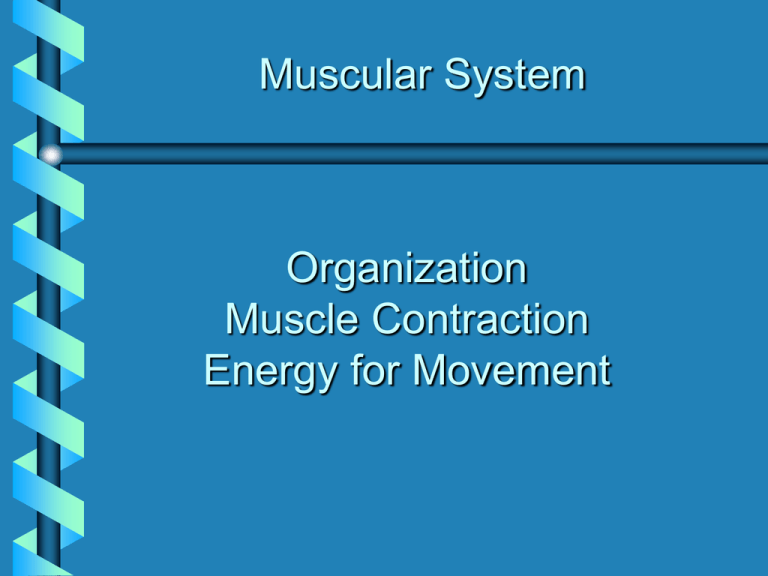
Muscular System Organization Muscle Contraction Energy for Movement Functions of the Muscular System • Supports the body • Makes the bones move • Helps maintain constant body temperature • Assists movement in cardiovascular and lymphatic vessels • Helps protect internal organs and stabilize joints Structure of Skeletal Muscle Each fascicle is a bundle of muscle fibers Whole muscle is a bundle of many fasicles The fascia surrounds the muscle Each sarcomere is made of actin and myosin fibers Each muscle fiber is a bundle of myofibrils Each myofibril is made of many sarcomeres Skeletal Muscles Work in Pairs • Muscles contract (shorten) or relax • Muscle contraction pulls on an attached bone • Prime mover = muscle doing the most work • Synergists = muscles assisting prime mover • Antagonist = muscle with action opposite to prime mover on stationary bone on bone that moves Ways to Name Muscles by location by attachment by direction of muscle fibers by shape by number of attachments by action by size Structure of a Skeletal Muscle Cell cytoplasm, contains organelles and myofibrils plasma membrane bundle of muscle cells (fibers) sarcolemma myofibril sarcoplasm one myofibril Skeletal muscle cell (fiber) Z line T tubule nucleus sarcoplasmic reticulum extensions of sarcolemma, contact sarcoplasmic reticulum one sarcomere contractile unit Smooth ER, stores calcium Z line Contains actin and myosin filaments for contraction Applying Your Knowledge 1. 2. 3. 4. 5. Synergist Sarcomere Myofibril Antagonist Muscle Fiber A. A fascicle is a bundle of ________. B. Which one assists the primer mover? C. Which one is the contractile unit? Structure of the Sarcomere Muscle has light and dark bands (striations) corresponding to the placement of myofilaments in the sarcomere. Sliding Filament Theory of Muscle Contraction Sarcomere shortens when actin filaments slide past myosin filaments and approach one another. Events at the Neuromuscular Junction Neurotransmitter is released into synaptic cleft between neuron and muscle cell Neurotransmitter binds to receptors on sarcolemma, impulse spreads down T tubules Sarcoplasmic reticulum releases calcium to stimulate contraction Events at the Sarcomere Attached to tropomyosin at regular intervals Calcium binds to troponin Arranged over myosin binding sites on actin filaments Events at the Sarcomere ATPase Enzyme Energy from ATPADP + P causes myosin heads to form cross-bridges that pull actin filaments toward the center of the sarcomere. Applying Your Knowledge 1. 2. 3. 4. 5. Troponin Actin Tropomyosin Myosin Calcium A. Which is released by the sarcoplasmic reticulum to stimulate contraction? B. Which one has ATPase activity? C. Which one binds to calcium? D. Which one slides past another fiber to shorten the sarcomere? Whole Muscle Contraction • Strength of Contraction depends on – number of muscle fibers contracting – number of motor units responding – number of muscle fibers within a motor unit Energy for Muscle Contraction built up in resting muscle anaerobic aerobic anaerobic Slow-and-Fast Twitch Muscle Fibers Motor units with many fibers
